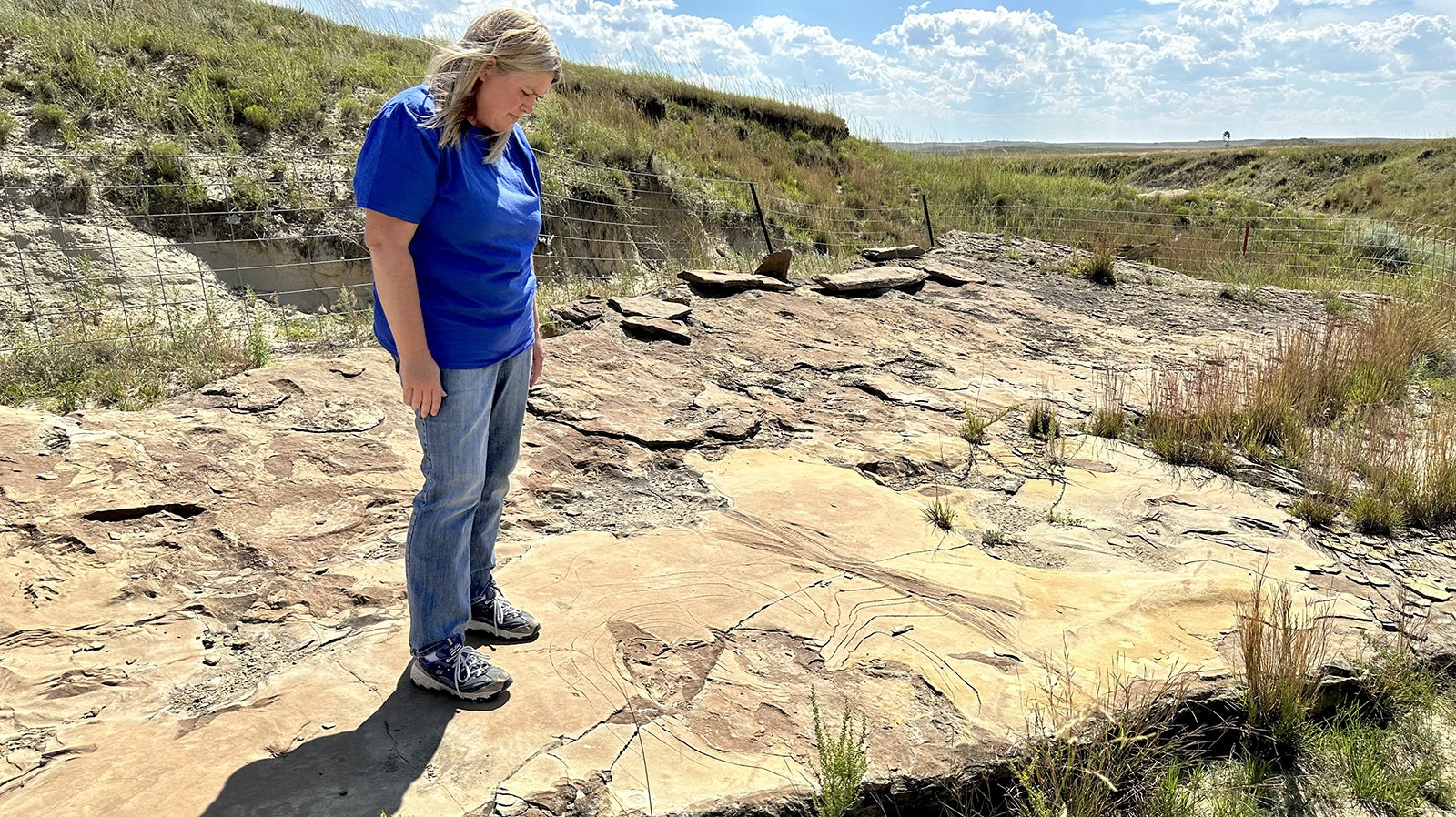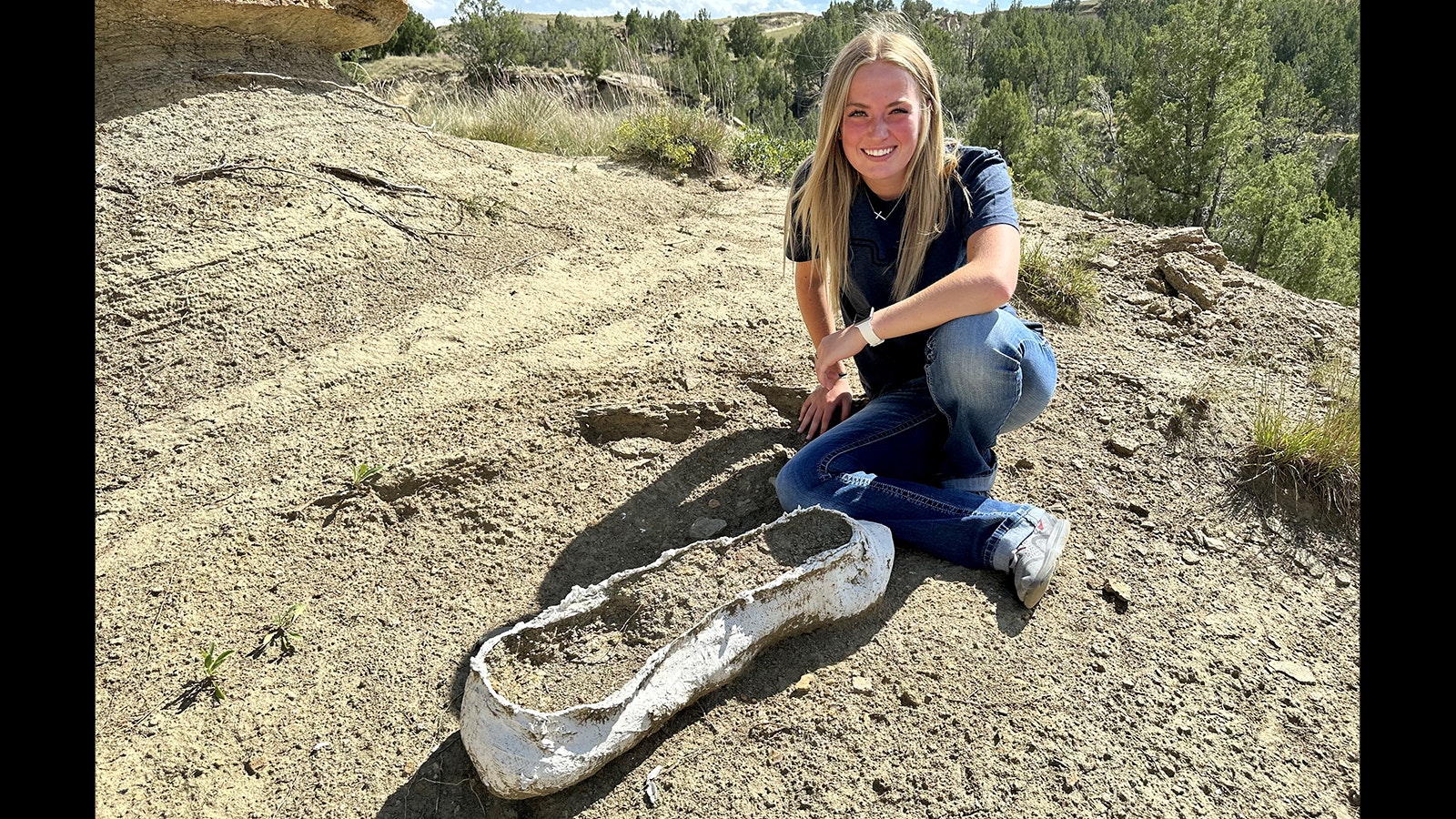NEWCASTLE — While there was plenty of summer left to savor, mid-August is the end of the season on the Zerbst Ranch. There were only a few days left to take the two-hour Paleo Park tour.
Kris Stauffer was the guide waiting for eager guests with a warm smile and friendly greeting, a welcome sight after driving over 20 miles down a dusty gravel road near Newcastle.
“We have two more groups this weekend, then that’s it for the year,” she said.
Kris was accompanied by her daughter, Jaden. It was her last week at home before returning to Black Hills State University to continue pursuing a degree in physical science.
The 7,000-acre ranch doesn't look too extraordinary, even with its sweeping vistas and curious patterns cut into the exposed rock outcrops. Charles Zerbst first homesteaded the area in the 1890s, and five generations of his family have called the ranch home since then.
The international visitors who take the two-hour tour come for the ranch's prehistory. Many who leave are most impressed by its family history.

A Density Of Dinosaurs
The tour began at the Paleo Park Lodge, a "home away from home" for the hundreds of people who’ve journeyed to the ranch seeking prehistoric treasure. Every Wyoming ranch must have its trophies on display. The Zerbst Ranch is no exception, although the family's trophies are unique to the ranch's legacy.
A Tyrannosaurus tooth. The jaws of adult and juvenile Edmontosaurus. A piece of Triceratops skin. Several serrated teeth from a variety of meat-eating dinosaurs.
Dinosaurs have brought visitors and scientists to the Zerbst Ranch for over a century. Fossils have been found and excavated on the property since 1908.
"My great-grandfather, my grandfather, my dad, me, and my kids have gone out to look for dinosaurs," Kristen said.
The fossils on the Zerbst Ranch come from the Lance Formation from the Late Cretaceous Period, roughly 69 to 66 million years ago. The rock layer preserves the last days of the dinosaurs' reign, the domain of the Tyrant Lizard King, Tyrannosaurus rex, along with Triceratops and many other legendary dinosaurs.
Each generation of the Zerbst Family has found significant specimens. Kris' grandfather helped excavate a mummified Edmontosaurus, now one of the crown jewels of the paleontology collection of the American Museum of Natural History in New York City.
Kris' mother, Arlene, discovered one of the most complete and best-preserved Triceratops skeletons ever found, partially covered with enormous patches of skin. That skeleton, named "Lane," is on display at the Houston Museum of Natural History.
Kristen highlighted a magnificent Pachycephalosaurus skull, which is well known but relatively rare in the Lance Formation. Like everything on the tour, the scientific significance is matched by a genuine emotional connection — Kristen's father, Leonard, found the one-of-a-kind skull.
"My parents wanted to name a dinosaur after each of their grandkids," Kris said. So far, there have been two named dinosaurs from the ranch: Lane and Kelsey, a Triceratops on display at the Indianapolis Children's Museum.
Jaden and her brother Wyatt are still waiting to discover the dinosaur skeletons that will bear their names. They aren't particular about what kind of dinosaur it will be.
"Just not a Triceratops," Jaden said. Triceratops is, by far, the most common dinosaur found in the Lance Formation.
Until then, the siblings continue a healthy competition to see who can find the best fossils when they spend time on the ranch.
Jaden admits Wyatt is winning, for now.

Leaving A Mark On The Landscape
It's a short drive from the lodge along a rugged two-track to the next stop on the tour. Along the way, Kris shared more information on the fossils on the ranch and the people who found them.
When Leonard Zerbst was told there were dinosaur footprints on the ranch, he didn't believe it. Once he saw them firsthand, he immediately removed half a hill with his backhoe to expose more of the layer.
The Zerbst Trackway is legendary in the paleontological community. Over 100 tracks from dinosaurs and other prehistoric species are preserved on the slanted slab of rock, which was once the bank of a river.
It's hard to see any signs of dinosaurs on the rock. Kris walked in the literal footsteps of dinosaurs and told the story while pointing out each track.
With her guidance, visitors can see the amble of a Tyrannosaurus, the quick steps of an ostrich-like Struthiomimus, and the distinct tail swish of a crocodile as it moved out of the water and out of the way of a lumbering Edmonotosaurus.
"You have herbivores and carnivores living together," Kristen said. "A perfect world!"
There are even tracks of a unique dinosaur: Saurexallopus zerbsti, a large oviraptor. Paleontologist Martin Lockley named the first of its kind footprint in honor of the Zerbst Family.
Leonard Zerbst envisioned the Paleo Park Lodge and the Zerbst Ranch tour as a way to share his family's passion with the world. Leonard died of esophageal cancer in May 2000, two months before the lodge was finished and the first tours began.
The family's love for each other and their home is evident. Leonard would be tickled to see his daughter and granddaughter eagerly continuing his passionate mission.
"It's a unique way to live," Jaden said. "Some days, you're fixing stuff on the ranch and doing stuff with cows. Other days, you're finding dinosaur bones."

Small Pieces With A Huge Impact
The final stop on the tour was a trip to "the beach," now in the form of a slope of eroding rock. But this is the part of the experience that changes lives.
Within minutes, everyone can spot a fossil. After a few minutes more, every guest could have a handful of crocodile teeth, gar scales, and small bits of dinosaur bone.
"The beach" is a collection of small fossils and fragments called a micro-site. It's not as immediately impressive as a complete skeleton or even a single large bone, but micro-sites contain pieces from every plant and animal that lived on the Zerbst Ranch 66 million years ago.
Once again, the science of the site is accompanied by a profound personal impact. But this time, the guests make a lifelong connection with the Zerbst Ranch.
"(Guests) are allowed to take what fossils they would like at our discretion," Kristen said.
This generosity has its detractors, who feel all the fossils should be preserved for research. While large and more significant fossils stay on the ranch, Kris believes these small pieces of the past can do more in the hands of their guests.
"A lot of people get grumpy with us that we allow our guests to take some of the (fossils) they find. People get to enjoy it and take it with them," she said.
Kris fondly recalled each of the "paleos" who have spent time digging dinosaurs on the ranch. They're more than visitors. They are friends and family.
Jaden and her brother Wyatt have close friends from West Hampton Beach, New York, who visited the ranch as part of a school trip. She knows people all over the world through the tour and teams of eager excavators who have stayed at the Paleo Park Lodge.
"We meet people from all around the country and all over the world. It's pretty fun," she said.

Family And Fossils Forever
The tour ended with a pocketful full of prehistoric pieces and plenty to think about.
On the way back to the Paleo Park Lodge, Kris pointed out a cairn stacked on one of the ranch's hills. The stones have stayed there since her great-grandfather Charles stacked them, a preserved glimpse into the past just as important as any footprint or fossil.
The few months when the ranch offers its two-hour tour are the best time of year for Kris. Every trip is an opportunity to share science and reconnect with a century of her family's history.
After 20 years of tours, Kris gets to see how her family's legacy has impacted the lives of others.
"Little kids that have come here are now grown with their own kids. They still remember coming here and finding their first bone. A lot of times, they still have it and show their kids," she said.
Kris intends to keep guiding tours and looking for fossils on the ranch. Jaden feels the same and said she can see herself carrying the torch for future generations.
"I know my brother and I would love to continue on the whole "paleo" thing for our families and keep it around for everyone else to come see," she said.
There's much more to find on the Zerbst Ranch, and people worldwide have a small piece of that legacy. And as long as there are dinosaur fossils to find, you'll find the Zerbst Family sharing their ranch’s treasure and heritage for generations to come.
Andrew Rossi can be reached at: Arossi@CowboyStateDaily.com
Andrew Rossi can be reached at arossi@cowboystatedaily.com.





